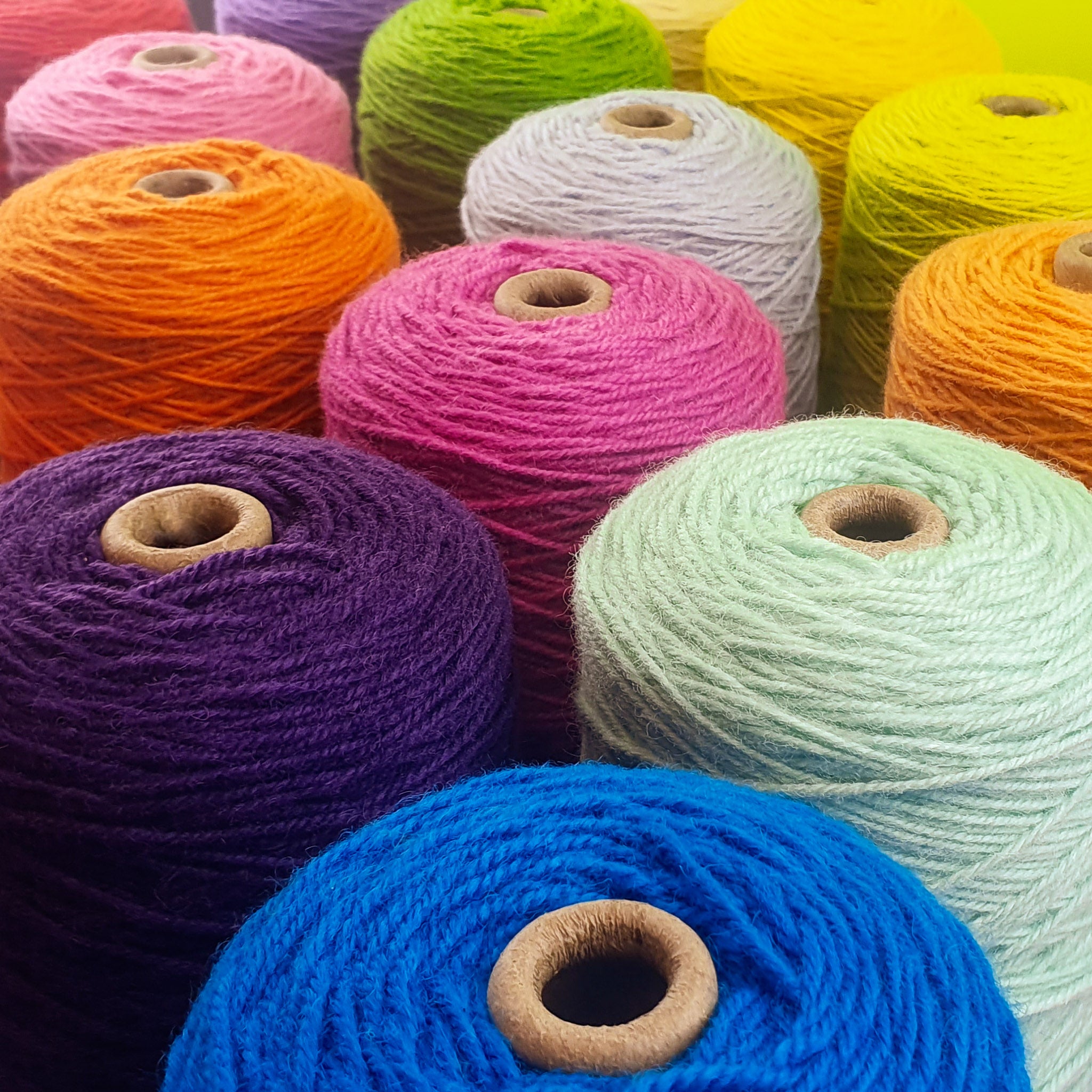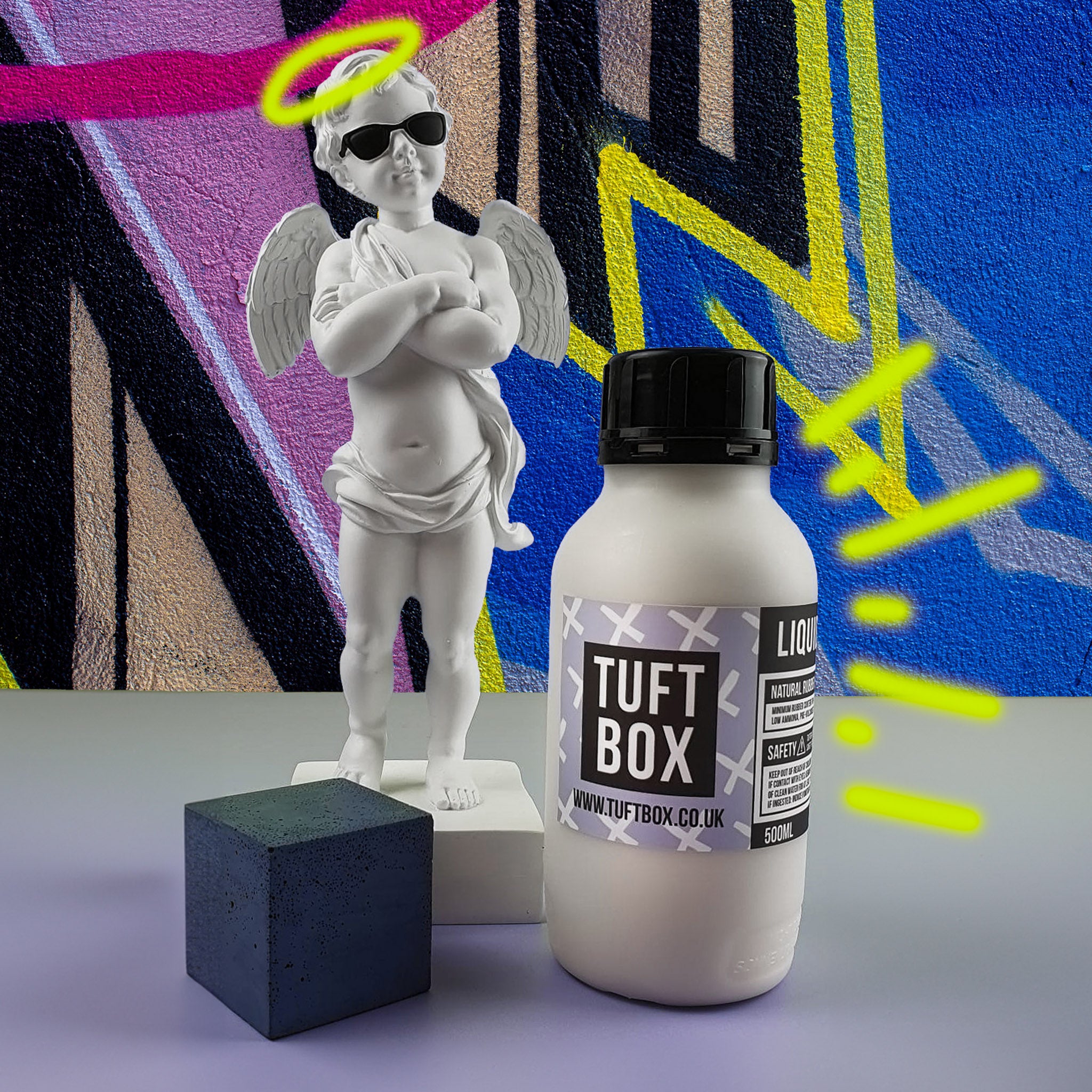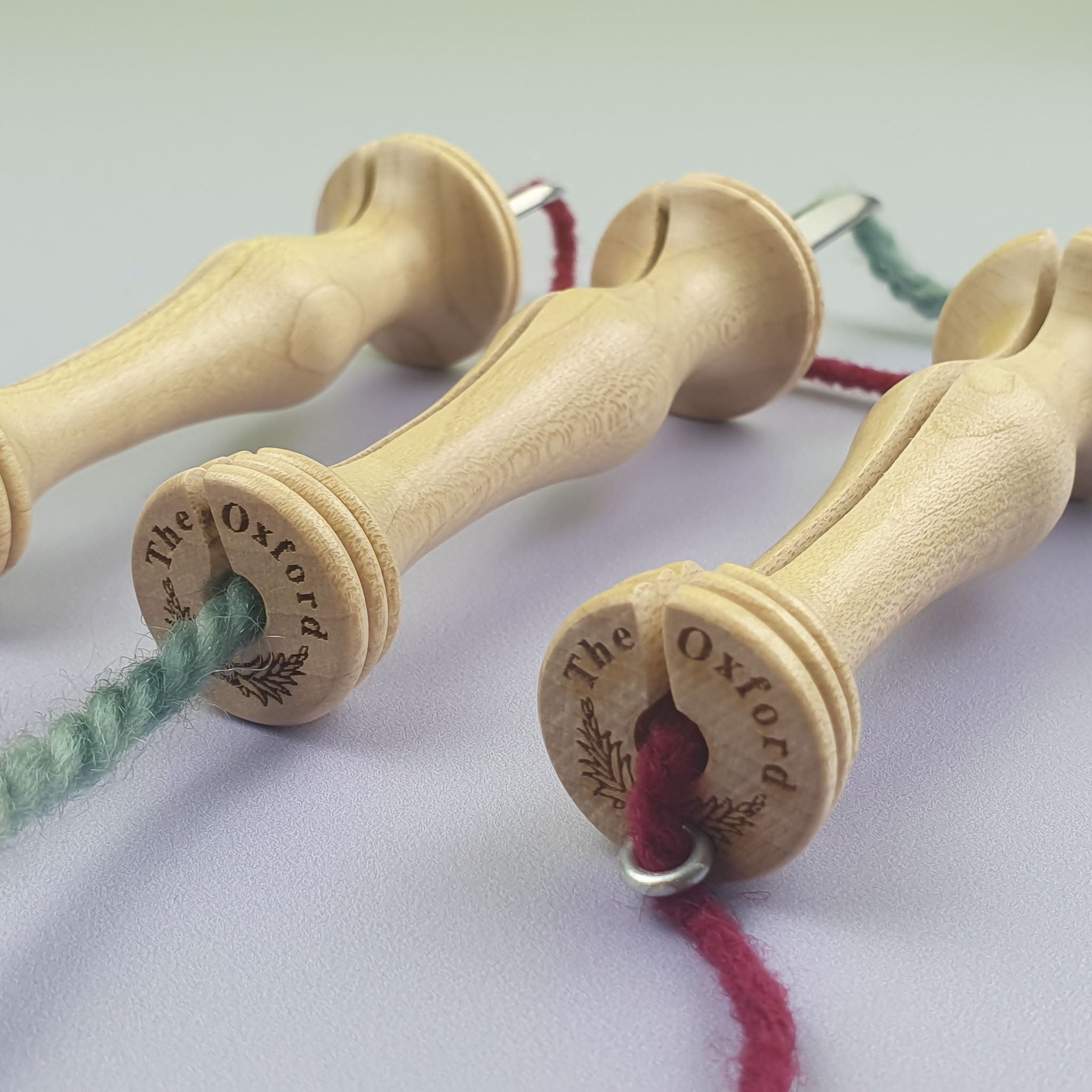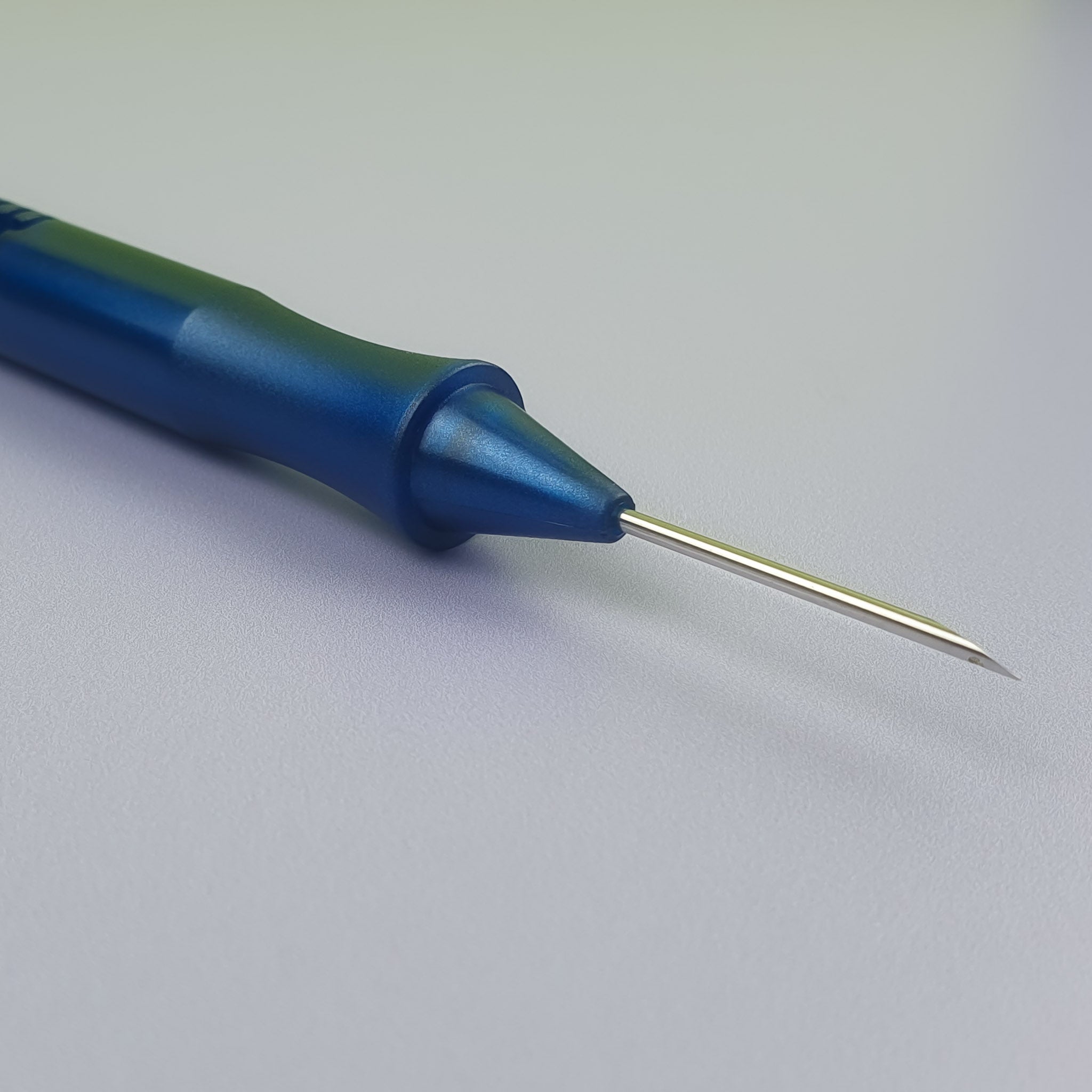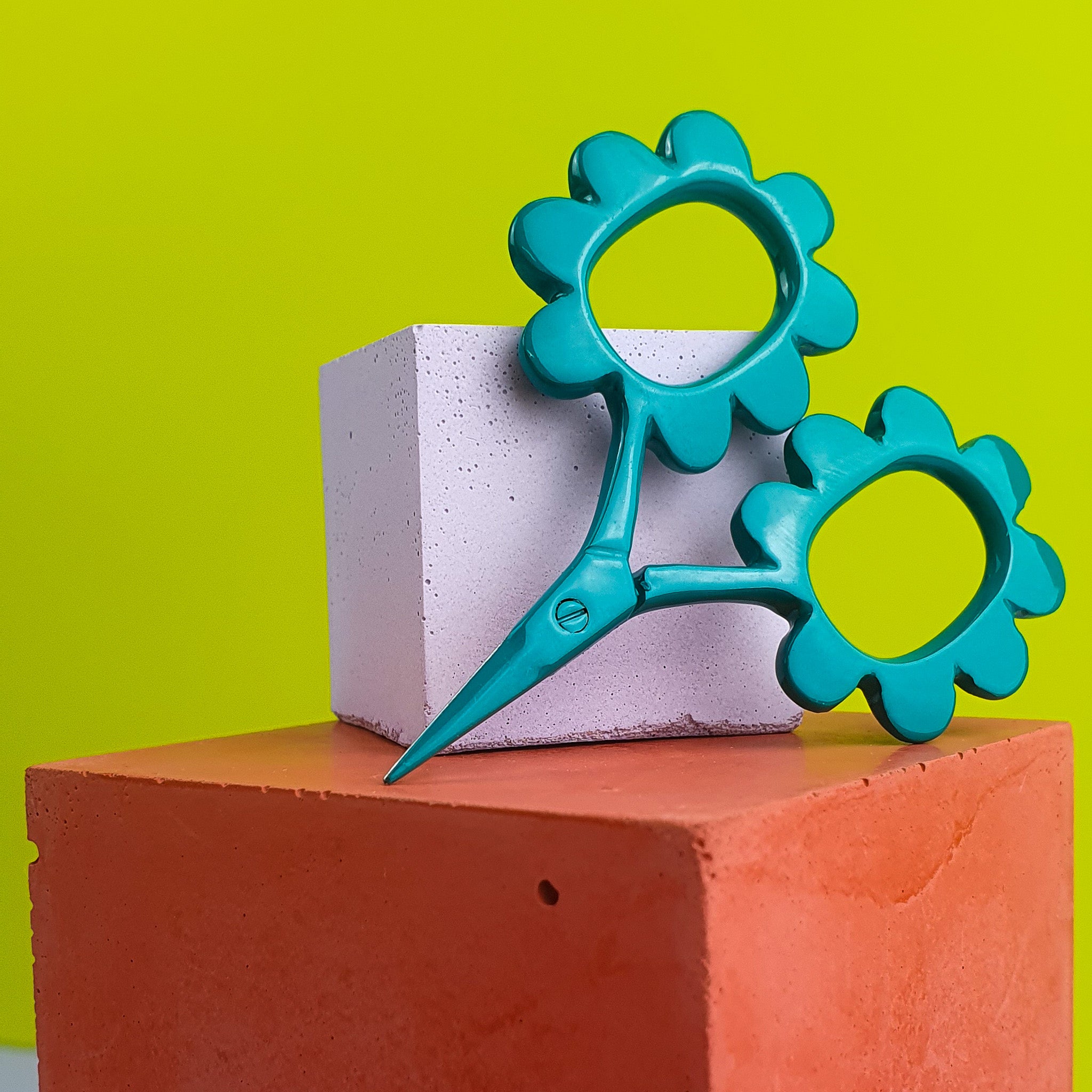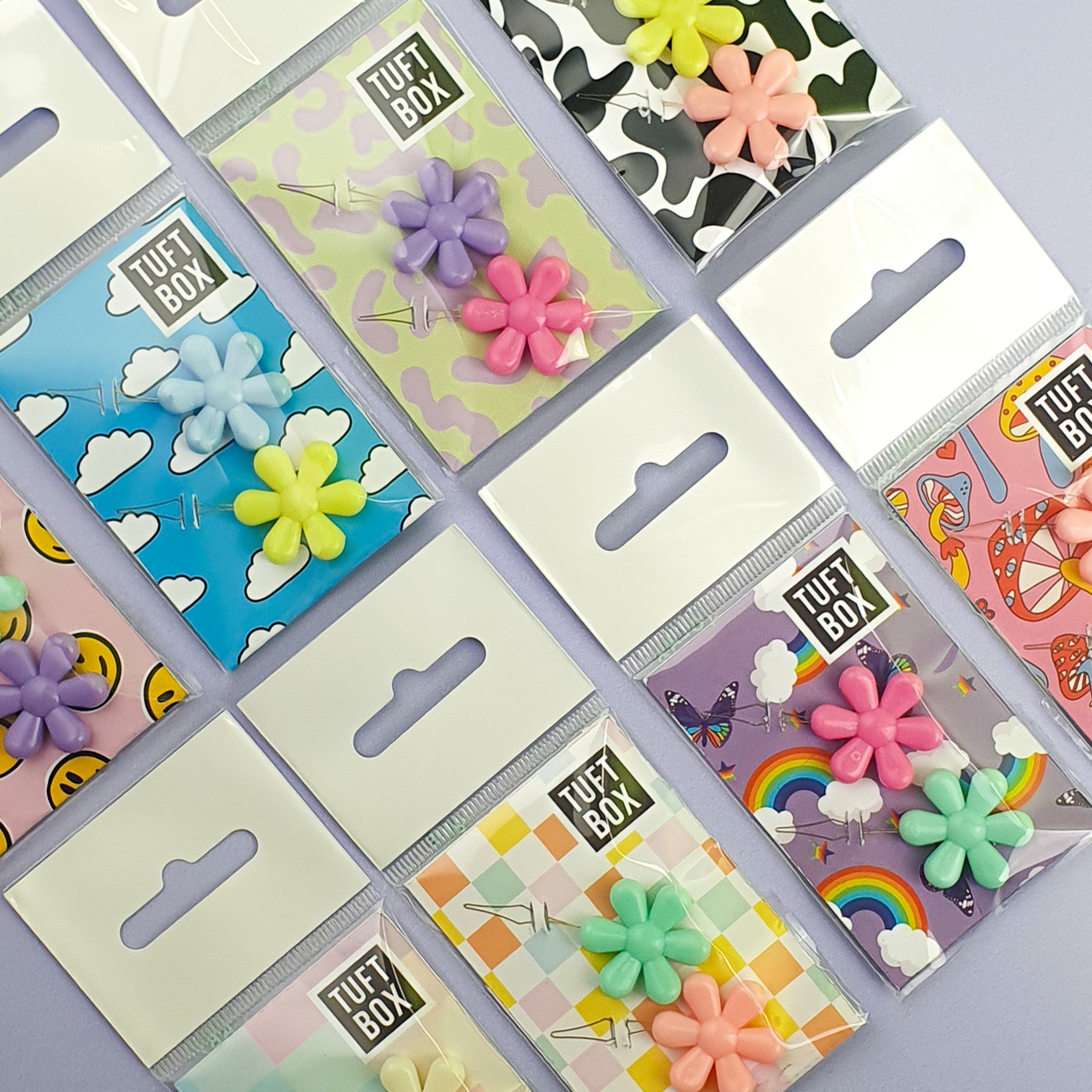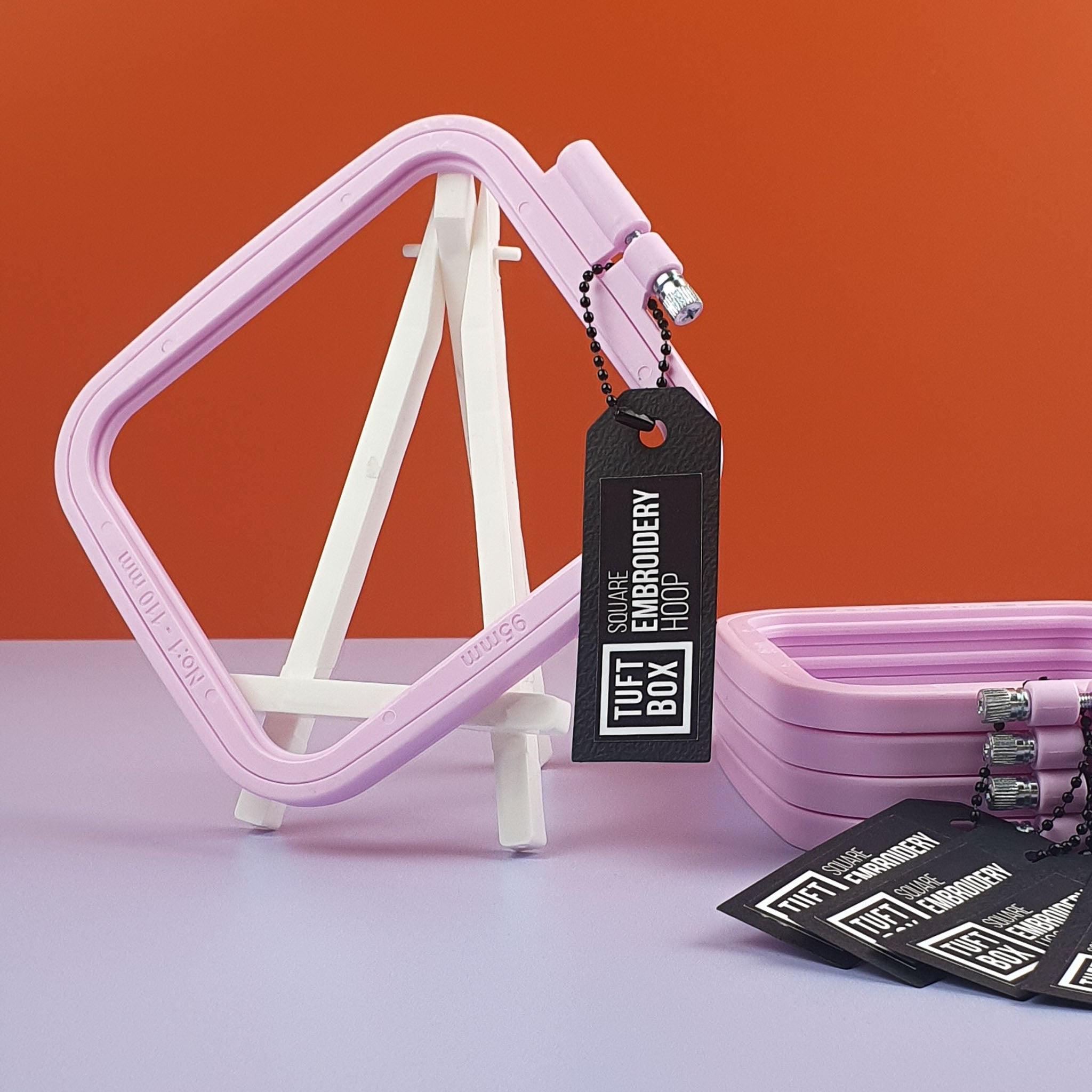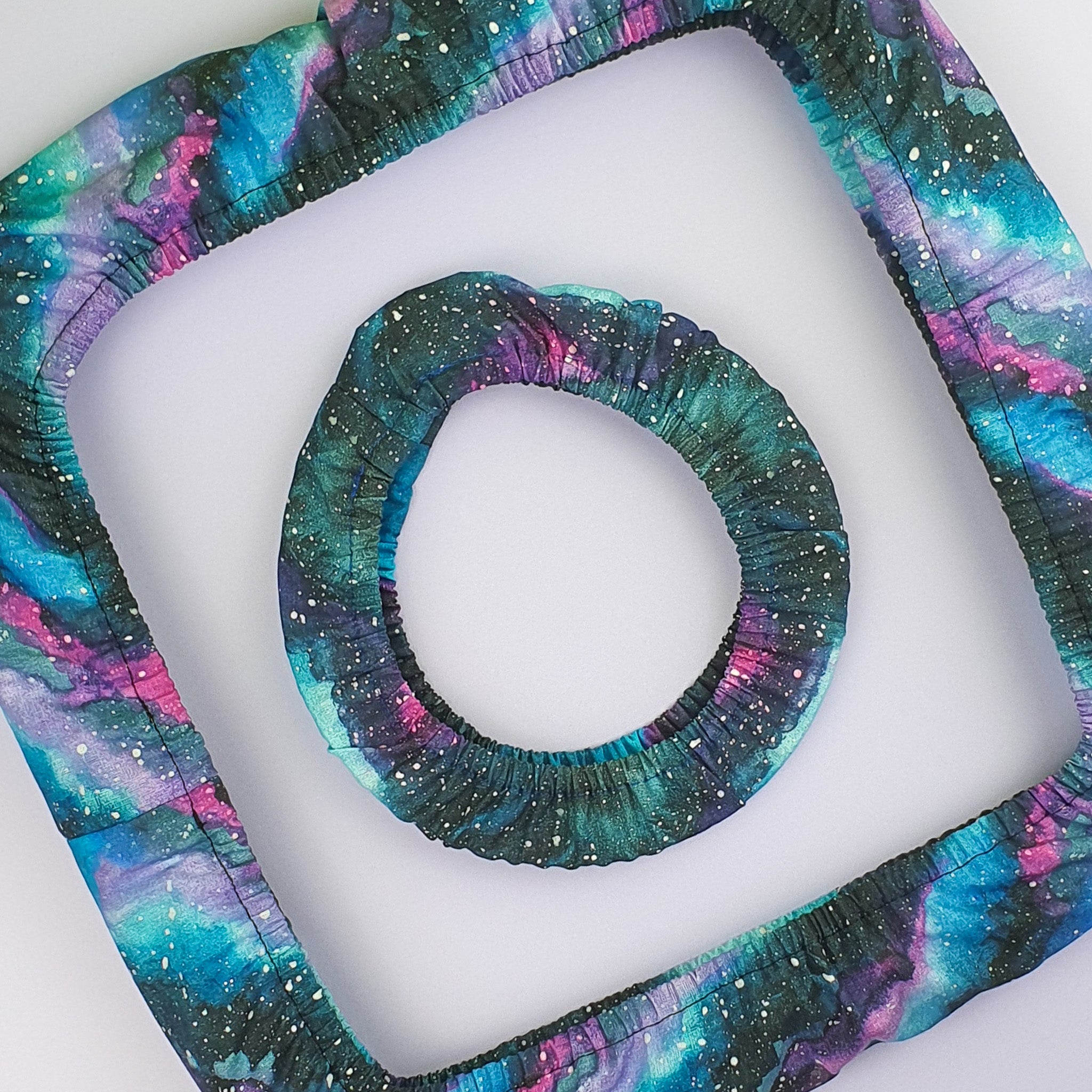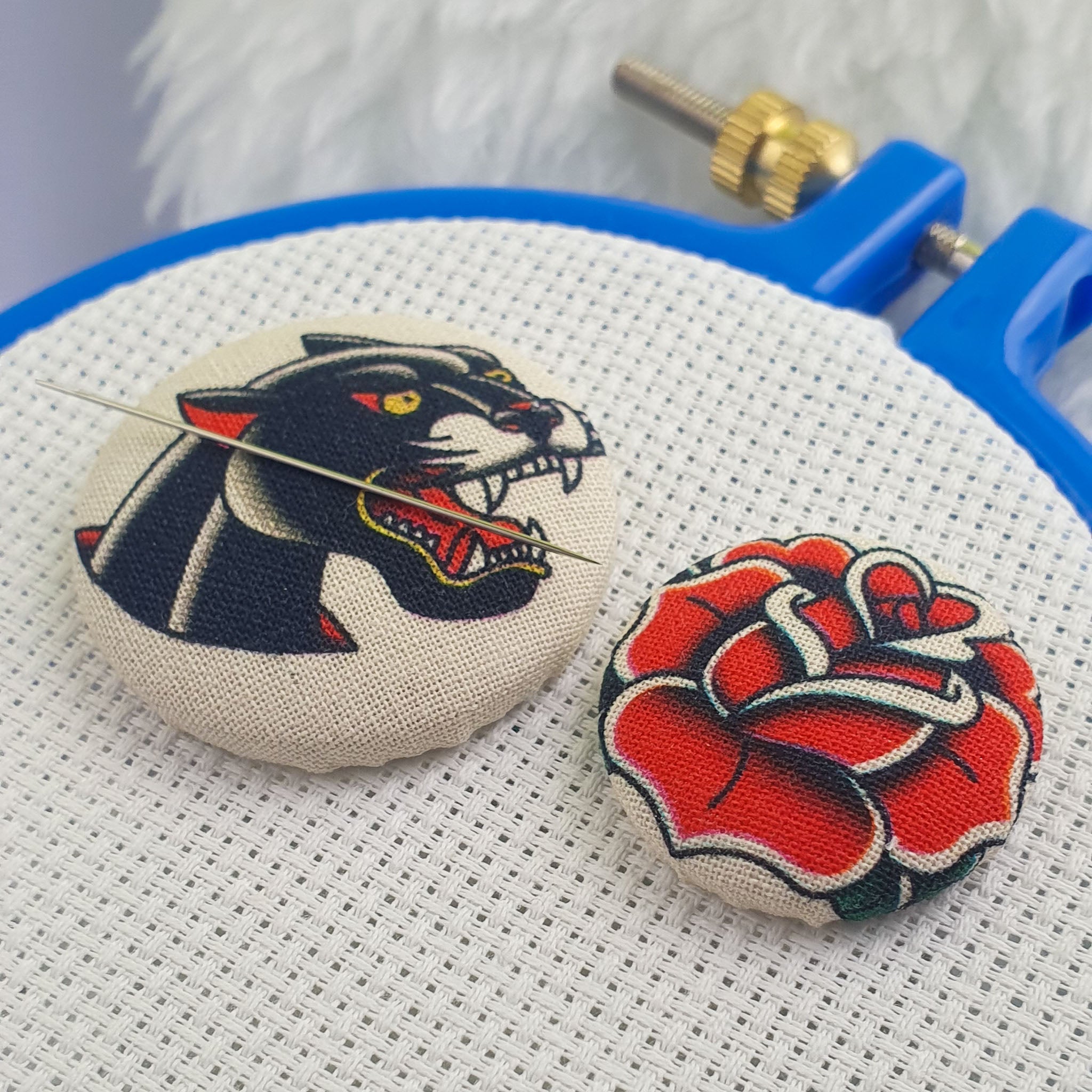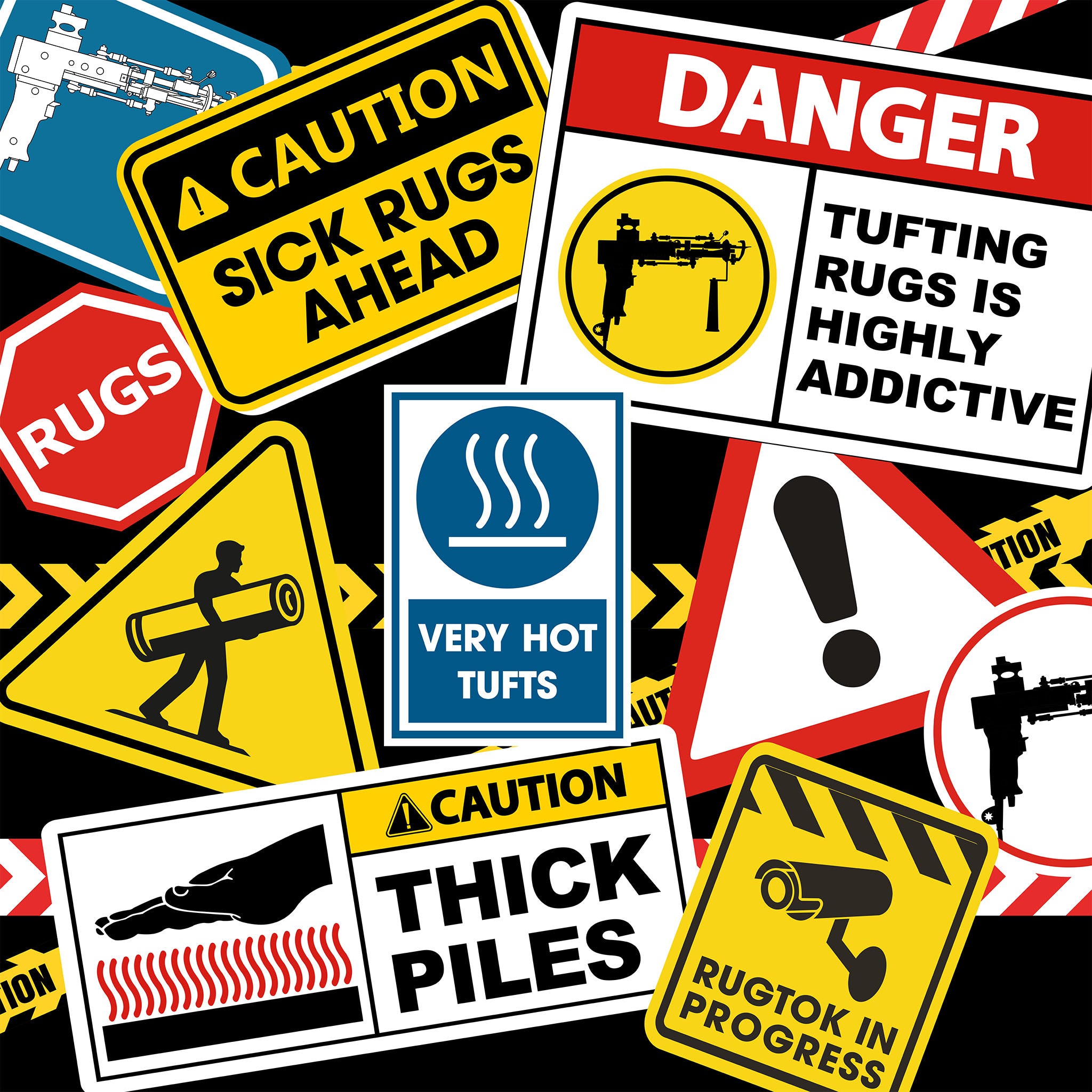Feeling overwhelmed by the different tools and materials you’ll need to start making rugs? You’re not alone.
The web is littered with conflicting information about what fabrics you’ll need, which gun is the best and where you should buy your supplies from. Many people spend hours researching, only to find that what they want isn’t available in their country or that it’s going to cost them a small fortune to get it delivered.
If you are based in the UK, lucky for you, this comprehensive guide is going to break down everything you need to know to get started. You will learn all about tufting, what tools and materials you will need and where you can get your hands on them in the UK.
What is tufting?
Tufting is a textile manufacturing technique, where strands of thread or yarn are inserted into a fabric base. A tufting gun is a hand-held electric power tool that uses this technique. It works by feeding strands of yarn through a needle that rapidly punches an upright stretched piece of fabric. With a tufting gun you can make a wide variety of textured textile products including rugs, tapestries, wall art, stool covers, mirror frames, cushions and even clothing!
What do I need to start tufting?
To start making things with a tufting machine you’ll need various specialised tools and materials:
- A tufting gun - At the heart of rug tufting lies the tufting gun, a hand-held machine that will transform yarn into a textured textile masterpiece.
- Primary tufting fabric - think of this as the canvas for your design, a blank page ready for you to paint with yarn.
- A tufting frame - Designed to hold your primary fabric tight whilst you use your tufting machine.
- Yarn - what gives your tufting its tufts! Yarn is a length of fibres which when punched into fabric produce the soft, fluffy textiles that we all know and love.
- Adhesives - tufting requires glue to bind the materials together. A primary glue is used to secure the tufts of yarn in place and a second glue is used for applying fabric to the back and edges.
- Secondary backing fabric - this is a fabric applied to the back of the tufted piece.
- Rug binding - materials used to secure and protect the edges of a rug.
- Carving tools - equipment used to cut, shape and shave the yarn.
Don’t worry if any of this sounds confusing at this stage, like any new craft it takes time to learn the terminology and techniques involved. In the next section you will learn more about the special tools and materials used in tufting. You’ll understand what materials work best for beginners and how to select the right materials for your creative project - whether that is a tufted floor rug or making something fluffy to hang on your wall!
What is primary tufting fabric?
Tufting requires a specific type of fabric that serves as a base for punching the yarn into. Commonly referred to as ‘primary backing fabric’, ‘primary tufting fabric’, or ‘primary tufting cloth’, this fabric is an essential component for crafting hand-tufted rugs.
What type of primary tufting fabric do i need to tuft?
Primary tufting fabric is a specialist textile, it needs to have both the right thread count for the gauge of the needle on your tufting machine and the right strength as you’ll be putting your weight behind the tufting gun whilst its needle is punching the fabric several times a second! The best primary tufting fabrics are made from woven polyester, this is the fabric most commonly used by the hand-tufting industry worldwide. 100% polyester primary tufting fabrics are the best but you can also find tufting fabrics in a polyester/cotton blend or 100% cotton. The reason why the professionals opt for 100% polyester is because it is much stronger than cotton and can withstand the pressure of the tufting machine. Polyester is also not affected by humidity whereas cotton absorbs moisture. A cotton-based primary tufting fabric can become saggy on the tufting frame with just a slight change of humidity.
Where can I buy primary tufting fabric in the UK?
Tuftbox stocks a premium grey primary tufting fabric that is made of 100% polyester. The fabric is made specifically for hand tufting and is used by professional rug tufters serving both residential and commercial clients.

Can I tuft with burlap, hessian or monks cloth?
When using fabrics that are not specifically manufactured for machine tufting, such as burlap or monks cloth, you will face challenges like; yarn falling out of the fabric mid-tuft, having to re-stretch your fabric often and having to deal with holes, tears and rips. It is highly recommended that beginners start their tufting journey with primary tufting fabric.
More experienced tufters that have got the basics down can absolutely experiment with different fabrics. You’ll need to adapt your techniques to minimise rips, for example modifying your speed and avoiding non-linear movements. Tuftbox offers a Hessian fabric which is a quality jute. It is very difficult to machine tuft and it is not suitable to use if you are looking to sell your tufted creations but it is a very affordable and eco-friendly option for crafters who are looking to experiment and test different tufting techniques.
What is a tufting frame?
A sturdy frame is one of the most important pieces of equipment in your tufting set up. It is designed to hold the primary tufting fabric taut. Tufting frames are generally constructed of wood, with carpet grippers around the edge of the frame. The carpet grippers have sharp angled nails, pins or tacks that hook into the fabric enabling the primary tufting fabric to be stretched tightly across the frame and held vertically in place.

How do I build a tufting frame?
Building your own tufting frame is a great option for tufters that have some experience of woodworking and know how to use power tools safely. If you’ve not used a saw or drill before, definitely ask an experienced friend or loved one to help you with constructing your frame.
The first step to building a frame is to decide what size frame you’d like to build. Be sure to check out this tufting frame guide, which includes the top 5 things to consider before you get building. You can buy materials for your frame at any standard hardware store, for UK tufters this could be Wickes or B&Q. You can find a shopping list of the things you’ll need to DIY a frame in the Tuftbox Tufting Frame FAQs and you can find helpful guides on youtube from other tufters who have constructed their own frames.
Where can i buy a tufting frame in the uk?
The Tuftbox Rug Tufting Starter Kit includes a frame that is perfectly sized for beginners. The frame is constructed in the UK using premium redwood pine. In the kit you’ll find detailed instructions for easy home assembly and everything you’ll need to clamp the frame to the edge of a standard tabletop.

What is a tufting gun?
A tufting gun (or tufting machine) is a hand-held electric power tool. It works by feeding strands of yarn through a needle which rapidly punches the yarn into a piece of fabric. A tufting machine is most commonly used for creating hand-tufted rugs but it can also be used to create a variety of textured textiles such as tapestries, wall art, stool covers, cushions, mirror frames and even clothing.
What are the different types of tufting machines?
Just like sewing machines there are lots of different models of tufting machines available at different price points. Different models may use different technologies or parts, they might have different functionalities or unique features and they may cater to different skill levels. The most expensive tufting machines (£700 to £3200+) tend to be both electric and pneumatic, meaning they must plug into the wall and connect to an air compressor to operate.
When it comes to choosing between tufting guns, the first decision you’ll have to make is whether you want a cut-pile, loop-pile or dual machine:
- Loop-pile machines - punch yarn through the tufting fabric in a continuous cycle, leaving loops of yarn. Loop-pile rugs have a knobbly texture.
- Cut-pile machines - push yarn through the fabric weave and cut the fibres, resulting in an upright pile with both ends of the yarn exposed. Cut-pile rugs have a dense fluffy texture.
- Dual machines - also called ‘duo’ machines, these tufting guns can perform both cut and loop pile tufting.
If you want to learn more, check out this blog comparing the pros and cons of cut and loop tufting.
What is the best tufting gun for beginners?
Over 90% of tufters choose cut-pile tufting machines - they’re easy to learn, create great-looking fluffy tufts, and are a more affordable option than dual-gun alternatives. The AK-I model is the most popular tufting gun on the market for hobby tufters. The popularity of the AK-I has stemmed from its competitive price and its reliability - having been tried and tested by thousands of people worldwide. Find out more about the AK-I.

Where can I buy a tufting machine in the UK?
Tuftbox is an official UK distributor for the AK-I Cut Pile Tufting Machine and is currently the only UK tufting shop distributing the genuine AK-I Tufting Machine 🇬🇧. The AK-I is the most popular tufting machine in the world and the top choice for beginners new to tufting.
The AK-I model comes from the manufacturer of the original AK series including the AK-I, AK-II, AK-II and the AK-DUO “The Duo”. With over two decades in the tufting industry, the manufacturer behind the AK continues to deliver unbeatable performance and reliability.

What yarn can I use for tufting?
Selecting the right yarn for tufting can be a daunting task with so many different options available. If you break your yarn options into four categories it can make your selection super easy!
Tufting Yarn Option #1 - Fibre
Yarn can be made from different materials and the type of fibre used will determine many of the yarn’s properties:
- Synthetic fibres, such as acrylic and nylon, are man-made. They are durable and often hypoallergenic, machine washable and come in a wide range of vibrant colours.
- Animal fibres, such as wool, silk and alpaca are known for cosiness, warmth and durability. Wool has been used to make rugs for millennia and is the traditional fibre used in carpets and hand-tufted rugs.
- Plant fibres tend to be lightweight, breathable, biodegradable and eco-friendly. Some examples include cotton, linen, hemp, jute and bamboo.

Your choice of fibre should come down to two main factors, the first is which tufting machine you plan to use. Entry-level cut-pile tufting machines, such as the AK-I, are often engineered with a scissor system to cut yarn; they perform at their best with the traditional rug tufting fibre - wool. Loop-pile tufting machines are often more tolerant of alternative fibres because there is no cutting of the yarn involved. Advanced tufting machines which are pneumatic and often used in industrial applications are engineered to handle a wide range of different fibres including synthetic and natural blends.
Secondly you should consider the type of project you want to create. Research the yarn to see how well its properties fit with what you are looking to create, for example:
- Cotton is a popular choice for home decor because it is durable yet soft. Its natural absorbency makes it a good option for tufted bath mats.
- Wool is the #1 choice for area rugs due its strength and durability. Wool fibres can bend 20,000 times without breaking and can stretch to more than 30% of their length and still return to their original shape. This means a wool rug can stand the test of time and maintain its appearance even in high traffic areas.
- Acrylic yarns are often lightweight, soft and can achieve bright and vibrant colours making them a fantastic choice for tufted art including wall hangings and tapestries, scatter cushions and other home decor projects.
When choosing your fibre may also want to consider:
- Price - synthetic fibres tend to be much cheaper to produce and therefore will reduce the cost of your project.
- Environmental impact - plant and animal fibres often have a far lower environmental impact than man-made fibres. Renewable, sustainable and biodegradable options such as wool tend to be the most eco-friendly.

Tufting Yarn Option #2 - Texture
Yarns can range from smooth and shiny to coarse and fuzzy depending on the spinning process and fibre content. Different yarn textures can add depth and personality to your tufted creations.
Similarly to fibre, the textures you opt for are influenced by the machine that you plan to tuft with. Cut-pile tufting machines, such as the AK-I, work best with coarse textured yarns. You should avoid tufting with very smooth, silky or shiny yarns which tend to slide out of the scissor mechanism, resulting in skipped stitches and machine jams. For effective cutting you will want to choose a coarse or bristly wool, or something similar in texture (see Tuftbox's Wool Rug Tufting Yarn below). Loop-pile and pneumatic machines may be more tolerant of silky yarns and alternative materials such as fabric strips. It’s always best to check the machine’s manual or with the manufacturer or supplier to see what yarns it can handle.

Tufting machines are generally not designed to work with speciality and novelty yarns which have unique textures. To prevent machine damage you should avoid tufting with any type of unspun yarn (roving), slub yarns, super fluffy / lumpy / hairy yarns, very soft yarns, mohair, bouclé, chenille, tweed yarns, plarn and other hard yarns, and most novelty yarns such as; faux fur, metallic, ribbon, eyelash and yarns with extra trims like nubs, bobbles, tinsel, pom poms, sequins, beads, lace etc.
Tufting Yarn Option #3 - Thickness
The thickness of the yarn you choose will determine the final look and feel of your project. Yarn thickness is often referred to as the “weight” of the yarn, and it’s usually categorised into different weight classes.

High-quality tufting machines are engineered to handle a range of different yarn weights. To achieve optimal density, the needle eye of the tufting gun should be full with yarn, while still being able to pull the yarn through the needle without excessive force.
With a thinner yarn you might need to thread your tufting gun with many strands to create a dense pile. In contrast, when tufting with thick yarn you may only require one strand in your needle.
You can also experiment with different combinations of yarn weights to achieve your ideal rug pile. For example, 3 strands of one thinner yarn might not work well but combining 2 strands of the thin yarn with 1 strand of a different thicker yarn might tuft great!
Tufting Yarn Option #4 - Colour
The final category of options for your tufting yarn is the easiest to grasp and the most fun - choosing the colour of your yarn! Here are some key terms to help you when selecting colours:
- Solid - yarns that come in a single colour.
- Semi-solid or tonal - yarns that have subtle hue or saturation shifts throughout their length.
- Variegated - multiple colours throughout the length of the yarn, colour changes can be abrupt or a gentle gradient.
- Ombre - gradual changes of colour usually a blend of hues of one colour or complementary colours.
- Gradient - gentle progression of different colours from light to dark throughout the yarn.
- Batch-dyed - yarn is coloured in batches in a dye bath, usually in industrial tanks. Variations in colours can occur between batches so make sure you get enough of each colour from the same batch to avoid colour inconsistencies in your tuft.
- Hand-dyed - yarn is dyed in pots or baths much smaller than industrial tanks. The dye can also be brushed, sprinkled or splashed onto the yarn.
- No Dye Lot - yarns labelled as “no dye lot” are the same colour no matter when you buy them. Typically mass-produced synthetic yarns where the manufacturer has obtained extreme consistency in the production process.

Where can I buy tufting yarn in the UK?
Tuftbox offers tufting yarns which are specially curated to work flawlessly with the AK-I Cut Pile Tufting Gun:
- Tuftbox Rug Wool is a 100% New Zealand Wool Yarn pre-wound on 500g cones. Two strands of rug wool in your AK-I will achieve a professional, soft and dense pile that can be easily carved to create high-detail, extra-clean tufts. The wool comes in 38 vivid colours that are sure to elevate your next tufting project.
- Red Heart Super Saver® 100% acrylic yarn is the perfect yarn for affordable cut-pile tufting. Two strands of Super Saver® yarn in your AK-I will create a soft, fluffy pile. With 68 solid colour options you should have no trouble finding the perfect colour for your tufted design. Super Saver® is made in the US and is OEKO-TEX® Standard 100 certified. The yarn is wound into easy to use 198g pull skeins.

What glue do I need for tufting?
Once you've finished tufting you'll need to apply a glue to the back of your piece in order to secure the tufts of yarn in place, this is called the primary adhesive. Liquid Latex is the most commonly used adhesive for sealing hand-tufted rugs and latex backing is used on 95% of carpets worldwide.
Professionals in the hand-tufting industry favour latex due to its liquid consistency, which allows for even coverage of every yarn tuft. Latex also provides the necessary dimensional stability to the rug whilst still allowing it to remain flexible. Learn more about liquid latex and how to apply it to your rug.
If you are making cut-pile wall hangings, pillows, or other decorative objects for the home that won't be placed on the floor and do not require flexibility, you can use any standard PVA glue. This also has a liquid consistency to penetrate through the fabric, ensuring there is a layer of glue to hold each strand of yarn nicely in place.
You will also need a glue to attach a secondary backing fabric and rug binding to your tufted project, this is a secondary adhesive. You will learn more backing fabric and bindings in the next sections of this guide.
Professionals frequently opt for liquid latex as the secondary adhesive for these applications also but you can also use a hot glue gun, fabric glue or a contact spray adhesive.
Where can I buy tufting glue in the UK?
Tuftbox stocks a high-quality liquid latex which is suitable for all types of rugs and tufted projects. Liquid latex is safe to use with a variety of yarns including wool, acrylic, cotton and with any type of primary or secondary backing whether natural or synthetic. It's also suitable for any type of flooring surface, such as carpet, hardwood, and even heated floors.
This liquid latex is made from natural rubber latex - an organic raw material. It is sustainable, renewable and an eco-conscious choice of adhesive. It is 100% free from animal by-products including Casein. It does not contain VOCs and is not hazardous to health or the environment. It is safe and regularly used in the production of medical goods, moulds and is even applied directly to the skin by SFX make-up artists.

What is secondary rug backing fabric?
Backing fabric, also known as secondary backing or final backing cloth, is applied to the back of a tufted piece, after the yarn has been sealed with glue. Backings are typically applied to rugs and carpets using latex, which creates a strong, durable bond. This extra layer of fabric provides many benefits, including:
- Adding a cushioning layer to make the rug or carpet softer and more comfortable to walk on.
- Helping to prevent slipping or sliding of the rug or carpet.
- Giving strength and stability to the piece.
- Protecting the underside from dirt and moisture.
- Improving the overall appearance of the piece by covering the tufted stitches on the back.
Do I need a backing fabric for tufting?
You don’t need to use a secondary backing fabric for every tufting project. It’s only needed if you are making a rug or you want to cover the back of your project.
Backing fabrics are not necessary for tufted creations that will not be placed on the floor or subjected to any wear and tear, you can simply seal your tufts with an initial layer of glue! When designing your tuft, consider what you will be using it for, if the back of the tuft will be on show you might want to opt for a backing for aesthetic reasons.
What fabrics can I use to cover the back of a tufted rug?
There are many different options for backing fabrics that you can use to cover and protect the back of a rug:
- Mesh Backing - Mesh fabric is the most commonly used backing for hand-tufted floor rugs. It looks like netting and typically is made from cotton or polypropylene (Action Bac®).
- Hessian/Burlap - Jute is a traditional fibre used in tufted carpet backing materials. It is a natural fibre that is sustainable, environmentally friendly and biodegradable.
- Felt - Felt is another common fabric used in carpet and rug construction due to its natural cushioning properties. Its spongy texture adds an extra layer of comfort underfoot, and also helps to improve sound insulation. Felt is also known for its durability and ability to withstand heavy foot traffic.
- Heavy Fabric Backing - Rugs can also be finished using a heavier woven fabric that provides both a durable and luxurious finish, look for heavy cottons and thick canvas fabrics.
- Anything else! - get creative and have fun experimenting with different types of fabrics for your rug backing! Upcycle fabrics from your stash or look for fabrics that are strong, hard-wearing and will provide good support and cushioning for your rug. Non-traditional backings can give your tufted creation a unique and personalised touch.

Where can I buy secondary backing fabric for tufting in the UK?
Tuftbox stocks a variety of fabrics that can be used as secondary backing fabrics for rugs and other tufted projects:
- If you are interested in backing your tufted rug like the pros check out the Cotton Mesh Rug Backing.
- This Hessian Fabric is a refined woven jute fabric that is an affordable and eco-friendly option for backing your rug.
- Looking for a luxurious finish? This black and white Premium Rug Backing will make the back of your rug look nearly as good as the front! This heavy woven fabric is both durable and aesthetically pleasing.
- If you are looking for a fun and affordable backing option check out this Viscose/Wool Felt. The felt is soft and cosy, comes in bold colours, and is a great option for novelty and craft rugs.
Do I need to finish the edges of a rug?
The edges of a rug are its most vulnerable point, they are the most exposed to wear and tear from foot traffic and vacuuming. Without a proper edge finish, the edges of your tufted rug will start to break down, the layers of the rug can seperate and tufted fibres can become loose. To ensure the longevity of your hand-tufted rug, especially if you plan to use it in your home or sell to customers, it's best to invest in a proper edging technique.
How to finish the edges of a tufted rug?
Most hand-tufted rugs are finished by two different methods:
- Binding - Binding the edge of a rug involves wrapping a strip of fabric around the edge of the rug and securing it in place via adhesive or stitching. In commercial rug making, this is typically done by a specialist tape binding machine.
- Whipping - Rug whipping typically involves the use of a specially designed machine (similar to a serger or overlocker). A whipped edge is created by wrapping a yarn or thread around the edge of the rug. This technique is typically more expensive than binding and creates a higher-end look. Some whipping machines also have over-edging capabilities where the edges are reinforced with an additional row of stitches beyond the standard binding or serging. Over-edging is typically used for high-traffic areas where the rug is subjected to extra wear and tear.
If you plan to use your tufted creation as a floor rug, you might want to consider having it finished professionally. Some rug and carpet specialists might be able to provide serging and binding services.
If you are looking to experiment with these finishing techniques for your rugs at home, they can definitely be achieved without a specially designed machine! For binding your rug, look for herringbone webbing which can be secured to the edges of your rugs by using an adhesive or by hand-sewing the binding to your project using a strong needle and strong thread. For whipping the edges of your rug, thread a yarn needle with your chosen yarn and manually create a whipped edge using a simple whip stitch.
Where can i buy tufted rug edging or binding in the UK?
Tuftbox has lots of products that can help you to edge your handcrafted rugs including three varieties of wide herringbone rug bindings. For smaller projects you can also try the 25mm herringbone rug binding which is available in bold and vibrant colours. These bindings can be secured to the edges of your rugs by hand-sewing using a strong needle and waxed thread.

By threading a wool needle with Tuftbox’s Rug Wool you can create a beautiful whipped edge. You can either match your yarn to the colour of your rug or use a contrasting colour for a more dramatic effect.
What tools do I need to carve a tufted rug?
Whether you carve or trim your tufted project or leave it au naturel is totally up to you as the artist!
If you are looking to achieve a professional uniformity in your rug, where the height of your rug is even across the pile, you will need a specialist rug shearing machine. You can achieve a similar, but less precise, effect by using an electric rug carving tool with a flat shearing guide attachment. The most popular tools amongst hobby tufters are repurposed pet hair clippers or sheep shearing machines, these both work fantastically with wool tufts, as wool, fur and hair are all made up of the same protein - Keratin.

Hand-held clippers and shearing machines also work great for getting creative with trimming to add definition and texture to the tuft. You can use them to carve 3D effects or to bevel the lines and shapes in your work to make the design stand out.
Ultimately you don’t need specialist electric tools to carve your tufted rug. You can achieve most of the same effects by using sharp scissors to trim your rug by hand. It’s worth noting that this can be a labour intensive process and purchasing a rug carver can definitely speed up the process for you.
Where can I buy carving tools for tufting in the uk?
Tuftbox has a variety of carving tools that can help you achieve great results in your tufted designs:
- Use the Rosewood Rug Carver to trim, round and shape your tufts. You can also pair the carver with this Shearing Guide to achieve a more uniform and sleek even pile.
- Duckbill Shears are good for carving details by hand. The shears have an angled blade to help you achieve super clean detailing, whilst the large duckbill design will keep your other rug tufts far away from your blade as you trim.
- Tweezers are a useful tool for achieving precise details, helping you to move individual tufts and make sure every piece of yarn is laying in the right section of your design. Tuftbox stocks a stainless steel Tweezer Set that has 4 great tools for yarnscaping.
- Small embroidery scissors and thread snips can help you to make micro-cuts in your tufted design and are a great tool for intricate detailing. These Putford scissors from Canadian designer Paula Sibbald have sharp durable blades, come in awesome colours and, despite their miniature size, they have larger finger holes than standard embroidery scissors making them the perfect tool for hands of all sizes.
- Rug carving can get messy pretty quickly, you can use these cute bear-shaped lint scrapers to remove excess fluff as you sculpt.
Where can i buy tufting supplies in the uk?
Now that you're acquainted with the essential tools and materials you will need to get tufting, check out the table below which has a summary of everything you’ve learned.
Pro has the professional hand-tufting supplies that will ensure you have a great tufting experience. Budget has supplies that are more wallet friendly but maybe harder to use, less aesthetically pleasing or result in tufted projects that won’t last as long.
| Material | 👑🐐 PRO | 💸🤑 BUDGET |
| Primary Backing Fabric | Premium 100% Polyester |
100% Cotton |
| Tufting Frame |
Tuftbox Rug Tufting Starter Kit - includes the AK-I Tufting Machine, fabric and a frame to get you started |
DIY your tufting frame - build your frame using local reclaimed or recycled wood to keep costs low |
| Tufting Machine |
The AK-I Cut Pile Tufting Machine Shop with Tuftbox UK to get the world's #1 tufting gun at the lowest price. No hidden import fees or taxes and 100% free delivery. |
|
| Yarn | Tuftbox 100% New Zealand Rug Wool |
Red Heart Super Saver® 100% acrylic yarn |
|
Primary Adhesive
(for sealing the back of your tufts) |
Liquid Latex |
Any PVA Glue (not suitable for rugs but can be used for wall hangings, pillows etc.) |
|
Secondary Backing Fabric
(only required if you are making a rug or if you want to cover the back of your project) |
Upcycle fabrics from your stash |
|
|
Secondary Adhesive
(for applying your secondary backing fabric and binding) |
Liquid Latex |
Contact Spray Adhesive |
| Rug Binding |
Professional finishing at a rug or carpet specialist |
Rug whipping with wool yarn |
| Carving Tools | ||
Tufting is a unique specialist craft that has a steep learning curve. Learning about the different tools and materials and sourcing them locally is one of the trickiest parts of getting started and now that you’ve made it through the guide you are well on your way to becoming a tufter! Tufting is an incredibly rewarding hobby and like most tufters, once you have your hands on your first rug, you’ll be super happy that you put in the effort.
Happy Tufting!
Didn’t find what you were looking for? Check out Tuftbox’s comprehensive FAQs for even more guides and the best tips and tricks for tufting.



